Como
This article may require cleanup to meet Wikipedia's quality standards. The specific problem is: An editor has added a lot of content related to the history of Como, but it is too wordy and written in poor english; a thorough cleanup is required. (March 2024) |
Como
Còmm (Lombard) | |
|---|---|
| Città di Como | |
 View of Como from Baradello Castle | |
UTC+2 (CEST) | |
| Postal code | 22100 |
| Dialing code | 031 |
| Patron saint | Saint Abbondio |
| Saint day | 31 August |
| Website | Official website |


Como (Italian pronunciation: [ˈkɔːmo] ⓘ,[3][4] locally [ˈkoːmo] ⓘ;[3] Comasco: Còmm [ˈkɔm],[5] Cómm [ˈkom] or Cùmm [ˈkum];[6]) is a city and comune in Lombardy, Italy. It is the administrative capital of the Province of Como.
Its proximity to
Como was the birthplace of many historical figures, including the poet Caecilius mentioned by
History
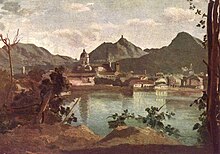
Ancient History
The hills surrounding the current location of Como were inhabited, since at least the
Around the first century BC, the territory became subject to the
Early Middle Ages
After the so-called "
Communal Era
The
The rise of Rusca/Rusconi family to power

Already in the second half of the
Modern Era
Subsequently, the history of Como followed that of the
20th century
At the end of World War II, after passing through Como on his escape towards Switzerland,
21st century
In 2010, a motion by members of the nationalist
The Rockefeller fountain that today stands in the
Geography and Climate
Situated at the southern tip of the south-west arm of Lake Como, the city is located 40 kilometres (25 mi) north of Milan; the city proper borders
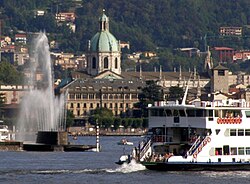
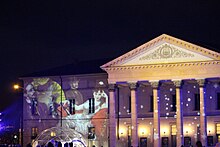
Climate
| Como | ||||||||||||||||||||||||||||||||||||||||||||||||||||||||||||
|---|---|---|---|---|---|---|---|---|---|---|---|---|---|---|---|---|---|---|---|---|---|---|---|---|---|---|---|---|---|---|---|---|---|---|---|---|---|---|---|---|---|---|---|---|---|---|---|---|---|---|---|---|---|---|---|---|---|---|---|---|
| Climate chart (explanation) | ||||||||||||||||||||||||||||||||||||||||||||||||||||||||||||
| ||||||||||||||||||||||||||||||||||||||||||||||||||||||||||||
| ||||||||||||||||||||||||||||||||||||||||||||||||||||||||||||
According to the
| Climate data for Como | |||||||||||||
|---|---|---|---|---|---|---|---|---|---|---|---|---|---|
| Month | Jan | Feb | Mar | Apr | May | Jun | Jul | Aug | Sep | Oct | Nov | Dec | Year |
| Record high °C (°F) | 21 (70) |
22 (72) |
24 (75) |
26 (79) |
31 (88) |
37 (99) |
38 (100) |
37 (99) |
31 (88) |
25 (77) |
22 (72) |
21 (70) |
38 (100) |
| Mean daily maximum °C (°F) | 6 (43) |
8 (46) |
13 (55) |
17 (63) |
23 (73) |
27 (81) |
30 (86) |
29 (84) |
23 (73) |
19 (66) |
12 (54) |
9 (48) |
18 (64) |
| Mean daily minimum °C (°F) | −2 (28) |
−1 (30) |
4 (39) |
7 (45) |
12 (54) |
16 (61) |
19 (66) |
19 (66) |
13 (55) |
9 (48) |
4 (39) |
2 (36) |
9 (47) |
| Record low °C (°F) | −18 (0) |
−16 (3) |
−11 (12) |
−5 (23) |
−1 (30) |
3 (37) |
7 (45) |
5 (41) |
4 (39) |
−3 (27) |
−9 (16) |
−10 (14) |
−18 (0) |
| Average precipitation mm (inches) | 79 (3.1) |
74 (2.9) |
109 (4.3) |
157 (6.2) |
201 (7.9) |
175 (6.9) |
137 (5.4) |
173 (6.8) |
160 (6.3) |
147 (5.8) |
127 (5.0) |
66 (2.6) |
1,605 (63.2) |
| Average precipitation days | 9 | 8 | 10 | 12 | 13 | 11 | 8 | 9 | 8 | 10 | 11 | 9 | 118 |
| Average relative humidity (%) (daily average)
|
84 | 76 | 69 | 74 | 72 | 71 | 73 | 72 | 74 | 81 | 85 | 86 | 76 |
| Mean monthly sunshine hours | 59 | 97 | 151 | 176 | 209 | 242 | 285 | 253 | 187 | 129 | 65 | 58 | 1,911 |
| Average ultraviolet index | 1 | 2 | 3 | 5 | 7 | 8 | 8 | 7 | 5 | 3 | 2 | 1 | 4 |
| Source 1: [33] | |||||||||||||
| Source 2: [34] | |||||||||||||
Government
The legislative body of the Italian comuni is the City Council (Consiglio Comunale); in Como, it comprises 32 councillors elected every five years with a proportional system, at the same time of the mayoral elections. The executive body is the City Committee (Giunta Comunale), composed of 9 assessori each overseeing a specific ministry, that is nominated and presided over by a directly elected Mayor (Sindaco). The mayor of Como since June 27, 2022, is Alessandro Rapinese, an independent leading an alliance bearing his name (Rapinese Sindaco), unaffiliated with any official political party.
Administrative subdivisions
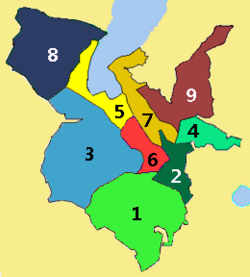
Como is divided into these
- Albate – Muggiò – Acquanera
- Lora
- Prestino – Camerlata – Breccia – Rebbio
- Camnago Volta
- City Center – West Como
- Borghi
- North Como – East Como
- Monte Olimpino – Ponte Chiasso – Sagnino – Tavernola
- Garzola – Civiglio
Main sights
Churches
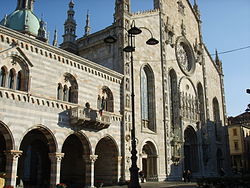

- Giuseppe Arcimboldi. The dome is a rococo structure by Filippo Juvarra. Other artworks include 16th–17th-century tapestries and 16th-century paintings by Bernardino Luini and Gaudenzio Ferrari.
- San Fedele, a Romanesque church erected around 1120 over a pre-existing central plan edifice. The original bell tower was rebuilt in modern times. The main feature is the famous Door of St. Fedele, carved with medieval decorations.
- Sant'Agostino, built by the Cistercians in the early 14th century, heavily renovated in the 20th. The interior and adjoining cloister have 15th–17th-century frescoes, but most of the decoration is Baroque.
- Basilica of Sant'Abbondio, a Romanesque structure consecrated in 1095 by Pope Urban II. The interior, with a nave and four aisles, contains paintings dating to the 11th century and frescoes from the 14th.
- San Carpoforo (11th century, apse and crypt from 12th century). According to tradition, it was founded re-using a former temple of the God Mercury to house the remains of Saint Carpophorus and other local martyrs.

Secular buildings and monuments
- The ancient town hall, known as the Broletto
- Casa del Fascio, possibly Giuseppe Terragni's most famous work. It has been described as an early "landmark of modern European architecture".
- Monumento ai caduti (war memorial) by Giuseppe Terragni
- Teatro Sociale by Giuseppe Cusi in 1813[35]
- Odescalchi family. It housed Napoleon, Ugo Foscolo, Prince Metternich, Archduke Franz Ferdinand I, Giuseppe Garibaldi, and other eminent figures. It is now a seat for exhibitions.
- Monumental Fountain also known as "Volta's Fountain", a monument to Volta's battery; it was designed by architect Carlo Cattaneo and painter Mario Radice and is a 9 m-high (30 ft) cement combination of alternating spheres and rings. It is in the centre of Camerlata Square.
- Ancient walls (medieval)
- the Tempio Voltiano, a museum dedicated to Alessandro Volta, a famous Comasco engineer, physicist, and inventor
- the Life Electric, a modern sculpture made by Daniel Libeskind
- Barbarossac. 1158
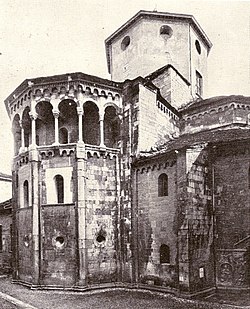
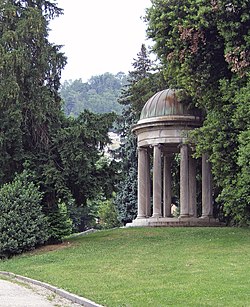
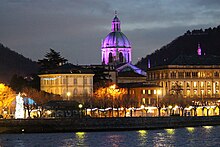
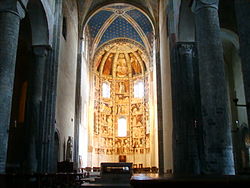
Economy
The economy of Como, until the end of the 1980s, was traditionally based on industry; in particular, the city was world-famous for its silk manufacturers, and in 1972 its production exceeded that of China and Japan,
The city and the lake have been chosen as the filming location for various recent popular feature films, and this, together with the increasing presence of celebrities such as Matt Bellamy who have bought lakeside properties,[40] has heightened the city's attractiveness and given a further boost to international tourism; since the early 2000s the city has become a popular "must-see" tourist destination in Italy.[41]
Demographics
The city of Como has seen its population increase until it peaked at almost 100,000 inhabitants in the 1970s, when manufacturing, especially the silk industry, was in its boom years. As production began to decline, the population tally decreased by almost 20,000 until the beginning of the 21st century, when the city saw its population grow again by more than six thousand units, generally due to increasing immigration from Asia, Eastern Europe and North Africa. As of January 2023, the population was 83,700 people of which 12,000 were resident aliens, that is, 14% of the total; the population distribution by origin was as follows:[42]
| Pos. | Origin | % |
|---|---|---|
| 1 | Italy | 86% |
| 2 | Europe | 5.3% |
| 3 | Asia | 4.1% |
| 4 | Africa | 2.8% |
| 5 | America | 1.8% |
| 6 | Oceania | 0.02% |
Top 20 nationalities of resident aliens:
| Pos. | Citizenship | Residents |
|---|---|---|
| 1 | 1155 | |
| 2 | 947 | |
| 3 | 791 | |
| 4 | 656 | |
| 5 | 604 | |
| 6 | 578 | |
| 7 | 545 | |
| 8 | 498 | |
| 9 | 470 | |
| 10 | 426 | |
| 11 | 411 | |
| 12 | 364 | |
| 13 | 313 | |
| 14 | 301 | |
| 15 | 234 | |
| 16 | 233 | |
| 17 | 214 | |
| 18 | 168 | |
| 19 | 164 | |
| 20 | 151 |
Culture
Museums
In Como there are the following museums and exhibition centres:
- Museo Archeologico "P. Giovio" – archeological museum
- Garibaldi Museum (Como) – a museum dedicated to Giuseppe Garibaldi
- Tempio Voltiano – a museum devoted to Alessandro Volta's work
- Villa Olmo – various exhibitions
- Museo Didattico Della Seta – educational silk museum
- Museo Liceo classico "A. Volta" – scientific museum
- Pinacoteca Civica – paintings and artworks from the Carolingian to modern era housed in the 17th-century Palazzo Volpi
Cuisine
Polenta is a popular dish in Como, and was traditionally eaten for meals in wintertime. It is obtained by mixing and cooking corn flour and buckwheat. It is usually served with meat, game, cheese and sometimes fish; in fact, Polenta e Misultin (Alosa agone) is served in the restaurants in the Lake Como area.
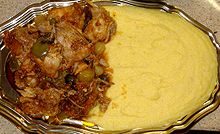
A traditional dish is the Risotto con Filetti di Pesce Persico or simply Risotto al Pesce Persico (European perch filet risotto), a fish grown in Lake Como, prepared with white wine, onion, butter and wheat.[43]
Palio del Baradello
In Como, a medieval festival called Palio del Baradello takes place annually.[44]
The first edition took place in 1981.
These pivotal moments for the town are celebrated by the medieval festival, where actors portray the main characters: Frederick Barbarossa, Henry the Lion, Beatrice of Burgundy, and Bishop Ardizzone, while citizens dress up in medieval attire.
During the Palio del Baradello, the town is divided into its historical wards called "Borghi" (in Lombard: "Burgh"[46]) Tavernola,[47] Quarcino,[48] Rebbio, Camerlata,[49] Cernobbio,[50] Cortesella[51] and Sant'Agostino.[52] The first day hosts the opening ceremony while in the following days the factions compete in different races to determine which district will win the year's edition.[53]
The final day of the festival consists of a grand parade where all the participants march across the town in medieval costumes, accompanied by animals, wagons, and replicas of siege engines, culminating in a ceremony where the emperor announces to the public which ward won the competition.


Symbology
Heraldry
The
Flags
Como has been using throughout history the Cross of Saint John as its flag: that been a white cross over a red field. Probably around the

Transportation
Rail
The Servizio Ferroviario Regionale (Regional Railway Service) connects Como by train to other major cities in Lombardy. Services are provided by Trenord through two main stations: Como San Giovanni and Como Nord Lago. There are five more urban stations (Albate-Camerlata, Albate-Trecallo, Como Borghi, Como Camerlata and Grandate-Breccia).
Como San Giovanni is also a stop on the main north–south line between Milan Centrale and
The

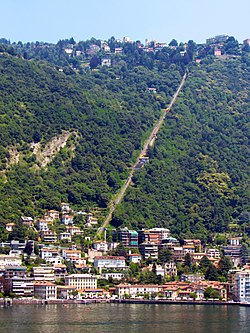
Buses and taxis
The local public transport network comprises 11 urban (within city limits) lines and 'extra-urban' (crossing city limits) (C) lines connecting Como with most of its province centres. They are provided by ASF Autolinee.
Ferrovie Nord Milano also provides other bus lines connecting Como to Varese in substitution of the original railway line that was dismissed in the 1960s.
Taxi service is provided by the Municipality of Como.
Ship transport
The boats and hydrofoils (aliscafi) of Navigazione Laghi connect the town with most of the villages sitting on the shores of the lake.
Airports
Nearby airports providing scheduled flights are
Aero Club

Como is home to the oldest seaplane operation in the world,

Education and health
Como is home to numerous high schools, the
In Como there are three major hospitals: Ospedale Sant'Anna, Ospedale Valduce and Clinica Villa Aprica.
Sports
Notable sports clubs are the
International relations
Como is
 Fulda, Germany, since 1960
Fulda, Germany, since 1960- Tokamachi, Japan, since 1975
 Nablus, Palestine, since 1998
Nablus, Palestine, since 1998 Netanya, Israel, since 2004[61]
Netanya, Israel, since 2004[61]
See also
Notes
- ^ "Superficie di Comuni Province e Regioni italiane al 9 ottobre 2011". Italian National Institute of Statistics. Retrieved 16 March 2019.
- ^ "Demo-Geodemo. – Maps, Population, Demography of ISTAT – Italian Institute of Statistics". Archived from the original on 21 November 2004. Retrieved 13 June 2016.
- ^ a b Migliorini, Bruno; Tagliavini, Carlo; Fiorelli, Piero. Tommaso Francesco Borri (ed.). "Dizionario italiano multimediale e multilingue d'ortografia e di pronunzia". dizionario.rai.it. Rai Eri. Archived from the original on 23 September 2015. Retrieved 12 February 2016.
- ^ Canepari, Luciano. "Dizionario di pronuncia italiana online". dipionline.it. Archived from the original on 9 October 2018. Retrieved 12 February 2016.
- ^ Carlo Bassi, Grammatica essenziale del "dialètt de Còmm", Como, Edizioni della Famiglia Comasca, 2014
- ^ Libero Locatelli, Piccola grammatica del dialetto comasco, Como, Famiglia Comasca, 1970, p. 6.
- ^ "Como, Italy. The best things to do in Como city". Lake Como Travel. 8 May 2019.
- ISBN 978-0-415-22410-9.
- ^ "Catullus". Archived from the original on 19 July 2011. Retrieved 17 January 2010.
- ^ "Alessandro Volta". Corrosion-doctors.org. Retrieved 21 June 2011.
- ISBN 9788863912685.)
{{cite book}}: CS1 maint: date and year (link - ISBN 8895383834.
- ISBN 8895383834.
- ISBN 9788863912685.)
{{cite book}}: CS1 maint: date and year (link - ^ Hundreds Of Roman Gold Coins Found In Theater Basement, Shannon Van Sant, NPR, 2018-09-10
- ISBN 978-8817168243.
- ^ "Beni culturali".
- ^ "Piano delle regole" (PDF).
- ^ "Comune di Como sec. XI - 1757". Lombardia Beni Culturali.
- ISBN 9788887867459.
- ^ "Comune di Como, sec. XI - 1757 – Istituzioni storiche – Lombardia Beni Culturali".
- ^ a b c d "Comune di Como, sec. XI - 1757 – Istituzioni storiche – Lombardia Beni Culturali".
- ^ Alberto Artioli, Il duomo di Como: guida alla storia; restauri recenti, Storie d'arte, Como, NodoLibri, 1990.
- ^ The National Cyclopaedia of Useful Knowledge Vol IV. London: Charles Knight. 1848. p. 811.
- ^ Maurisse, Marie (22 June 2010). "Quand un député suisse rêve d'annexer la Savoie". Le Figaro. Retrieved 22 June 2010.
- ^ "SVP-Forderung: Vorarlberg soll Kanton werden". Der Standard. 21 June 2010. Retrieved 22 June 2010.
- ^ Coen, Leonardo (22 June 2010). "L'ultima tentazione di Como: "Vogliamo diventare svizzeri"". La Repubblica. Retrieved 22 June 2010.
- ^ "Bronx Park Highlights". Retrieved 18 January 2011.
- ^ "Historical Weather in February 1987 in Como". weatherspark.com.
- ^ "Historical Weather". weatherspark.com.
- ^ "Caldo Natale sul lago di Como, il termometro sfiora i 20 gradi: colpa del Foehn" (in Italian). informazione.it. 25 December 2023. Retrieved 6 March 2024.
- ^ "Nubifragio, raffiche di vento a 100 km/h, grandine come palline da golf" (in Italian). quicomo.it. Retrieved 6 March 2024.
- ^ "Historical Weather". weatherspark.com. Retrieved 13 March 2024.
- ^ "Como Climate". Weather-atlas.com. Retrieved 15 June 2020.
- ^ "Il tetatro socilae di Come (in English)". Archived from the original on 3 July 2013. Retrieved 28 April 2013.
- ^ "Lake Como's Silk". lakecomotravel.com. 16 June 2019. Retrieved 13 December 2022.
- ^ Tagliabue, John (10 April 1997). "Italian Silk Industry Upset By a New U.S. Trade Law". The New York Times. Retrieved 18 July 2010.
- ^ "Cross-border commuters". Admin.ch. Retrieved 19 November 2022.
- ^ "Turismo a Como, i pernottamenti crescono del 28% rispetto al 2022" (in Italian). espansione TV. 22 September 2023. Retrieved 6 March 2024.
- ^ "Muse's Matt Bellamy Lists Lake Como Condo". Variety. 16 May 2017. Retrieved 17 June 2020.
- ^ "Best Places to Visit in Italy". US News. Retrieved 7 October 2021.
- ^ "Statistiche Istat". Istat. Retrieved 6 March 2024.
- ^ "Food and Culture Encyclopedia:Northern Italy". answers.com. Retrieved 5 April 2010.
- ^ "Palio del Baradello di Como".
- ^ "Palio del Baradello di Como".
- ISBN 978-8897180678.
- ^ "Palio del Baradello di Como".
- ^ "Palio del Baradello di Como".
- ^ "Palio del Baradello di Como".
- ^ "Palio del Baradello di Como".
- ^ "Palio del Baradello di Como".
- ^ "Palio del Baradello di Como".
- ^ "Palio del Baradello di Como".
- ^ a b c https://www.comune.como.it/it/comune/stemma-gonfalone-e-logo/stemma-comunale/
- ^ "Lugano Airport". Flightradar24. Retrieved 16 August 2023.
- ^ "The World's Best Hotel Bars: Terrazza 241 In Lake Como, Italy". www.forbes.com. Retrieved 4 July 2022.
- ^ AIP Italia AD2 LILY
- ^ "The historic fleet". www.aeroclubcomo.com. Retrieved 4 July 2022.
- ^ "Aero Club Como". Retrieved 20 September 2014.
- ^ "Città Gemelle". Comune di Como. Retrieved 7 October 2021.
- ^ "Netanya – Twin Cities". Netanya Municipality. Archived from the original on 1 February 2013. Retrieved 1 August 2013.
Sources
External links
- Official website (in Italian and English)
- Official Tourism Portal
- Historical picture gallery and slideshow
- Official Tourist Board website (in Italian and English)
- Lake Como Navigation Company
- Official Virtual Tour
- A documentary about the Lake by Yann Arthus-Bertrand




